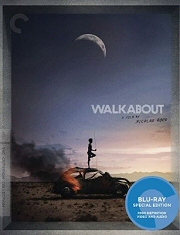- Rated R
- Drama
- 1971
- Buy the Blu-ray
Reviewed by Ross Ruediger
()
f cinema, at its core, is a visual art form, then Nicolas Roeg’s debut feature “Walkabout” is surely one of the greatest examples of filmmaking. The screenplay, written by Edward Bond, was allegedly only 14 pages long, and yet the movie has a 100-minute running time. It isn’t hard to believe that tidbit once you see the movie, as the dialogue is sparse, and yet it has the power to hold the viewer in its grip as effortlessly as something written by David Mamet. The characterizations, of which there are really only three, are as rich as the breathtaking scenery, which, when it comes down to it, is probably the real star of “Walkabout.”
The story begins with a father taking his teenage daughter (Jenny Agutter) and much younger son (Luc Roeg) into the Australian outback for a picnic. But something is wrong with the man, and while the girl sets up the lunch, the man pulls out a gun and starts firing at his children. They take cover behind some rocks, and soon enough the father just loses it altogether, douses the car in gasoline, sets it on fire and then takes his own life. It’s a horrific sequence, made vaguely palatable by today’s standards, only because we hear stories like this all too often on the news. Or perhaps that simply makes it more relevant. The girl does a good job of convincing the boy that they must go on ahead without their father, and that “he’ll meet them later,” as the boy doesn’t really understand what happened. And so the girl and the boy (we never do learn their names) are stuck in the middle of nowhere, with no idea how to get home or how to survive.
They move on, and just when the girl begins losing hope, they encounter a lone Aboriginal boy (David Gulpilil) who is on a walkabout, which is a right of passage for his people. He befriends them, despite the language barrier, and takes care of them, teaching a much different way of life – one based on living off of (but still respecting ) the land. Eventually, the trio forms a sort of family unit akin to mom, dad and son. It seems as if several weeks go by, although time probably doesn’t matter much in this movie. In the third act, they come across an abandoned house. Can these three survive and live here together? “Walkabout” has one of the saddest, most poignant endings I’ve ever seen in a movie – one that makes you go back and reconsider the entire picture. It’s by no means a Shyamalan twist, but rather a subtle shock to the senses.
It isn’t correct to say that “Walkabout” is slow, or that it has no story, although there will probably be people who will watch it and say both of those things. That’s unfortunate, because it moves along at a perfect pace, and is loaded with story, provided one dares to look through the eyes of its innocent characters. The Aboriginal boy’s dialogue has no subtitles, so conversations are frequently one-sided, but that was likely the point. Why should we understand what he’s saying if the other characters do not?
The pictures are breathtaking. Roeg’s eye grabs every frame of the outback it can possibly devour. One sequence – probably the film’s most famous – features Agutter swimming in the nude. It’s a gorgeous section of film and not particularly sexual, but rather freeing, and yet there’s no question that she’s beauty defined. What many don’t mention is that the scene is intercut with shots of Gulpilil killing animals for food, and yes, animals were harmed during the making of this movie. So if you’re offended by a naked 16-year-old girl or watching kangaroos (amongst numerous other animals) die onscreen, then this is most definitely not the movie for you. It could never be made and released today without its director going to jail, or at the very least never working again. But it’s important and should be seen by anyone with any serious interest in film, and it’s just as strong today as when it was released nearly 40 years ago.
Criterion Collection Blu-Ray Review:
Having owned this film on both laserdisc and DVD (both from Criterion), I probably had unreasonably high hopes for this new Blu-ray transfer. While there’s no question this version towers above any previous release, there’s still no mistaking that this is a 40-year-old low budget feature made by a handful of people. Still, it’s difficult to imagine it looking any better than it does here, especially after going back and looking at my old DVD, which was full of dirt and crud. The commentary track with Roeg and Agutter has been ported over from the previous release. There are two new video interviews – one with Agutter, and one with Luc Roeg; the one with the younger Roeg is especially enlightening, as he recounts his memories of making the movie from an adult standpoint. But the highlight here is an hour long documentary on David Gulpilil from 2002 titled “Gulpilil – One Red Blood.” It’s a fascinating account of this unique man’s life, both in front of and away from the camera. There’s also the theatrical trailer and a gorgeous booklet enclosed with an essay by author Paul Ryan.
You can follow us on Twitter and Facebook for content updates. Also, sign up for our email list for weekly updates and check us out on Google+ as well.












